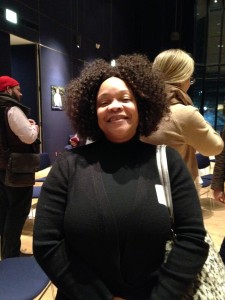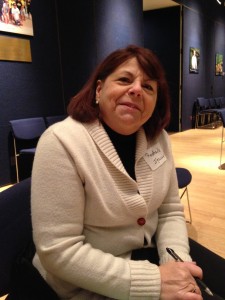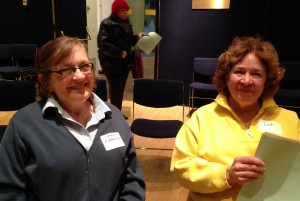Faculty Spotlight: “Hair and Other Stories” in U-M Classrooms
This post was written by UMS 21st Century Intern Grace Bydalek.
On January 12th, 2018, UMS rang in the new year with a performance of Urban Bush Women’s Hair and Other Stories in the Power Center for the Performing Arts. Urban Bush Women’s work focuses on text with the history, culture, and spiritual traditions of African Americans and the African diaspora. Artistic Director Jawole Zollar weaves together the boundary-pushing non-linear stories through dance, music, and spoken word.
Hair and Other Stories was crafted through interviews and other personal narratives, highlighting the struggles and complexities of our current world and times ahead. Original compositions by The Illustrious Blacks underscore dynamic movement and storytelling about gender identity, economic inequalities, body concept, race, freedom, liberation, and release in this extraordinary time.
Faculty across a variety of schools at the University of Michigan chose to integrate this engaging performance into their syllabi, exposing their students to the world of performance art and modern dance. Below, some of these faculty discuss the impact of Hair and Other Stories on their courses and students.

Photo: Urban Bush Women. Courtesy of artist.
Clare Croft brought the students in her course Dancing Women/Dancing Queer to the performance of Hair and Other Stories. The students had been prepared for the performance over the duration of the semester. Croft explains, “The students read portions of dance scholar Nadine George-Graves book on Urban Bush Women, did class exercises focused on movement description, and then attended the performance as their first step in their performance analysis paper. For the paper, students had to take notes on the physical, material details of the performance; and then write a paper in which they described a significant moment in the performance, contextualize that moment in the performance as a whole, and then discuss how that moment raised questions about gender and sexuality.”
Croft observed her students’ curiosity and increased engagement in the course after the performance. They were, as she describes it, “struck by the overt discussion of race and gender, which some thought was moving and some thought demonstrated a lack of trust in dance’s ability to make meaning.”
Petra Kuppers exposed her undergraduate students in Health, Gender and Performance, a course run as a collaboration between LSA’s Women’s Studies and the Theatre Department. In the class following the performance, Kuppers and her students created their own movement material from their “body histories,” inspired by Urban Bush Women’s physical movements.
“We used the theme of ‘everyday rituals,’ and students wove performances of worship and communal meals together with moments of private movement, abstract patterns that held memories for them, and that they shared with and taught to their co-performers,” Kuppers explains. She immediately observed a change in the way that her students, many of them pre-medical, engaged in the course material. “As it was early on in our course, this was the first time the students performed for each other, and it was a pleasure to see the energy and delight unlocked by seeing and then engaging dance work together,” Kuppers states.

Photo: Urban Bush Women. Courtesy of artist.
Joel Howell’s Medical Arts Program focuses on the benefit of the arts on medical practice, and is done in cooperation with the medical school Office for Health Equity and Inclusion. Given the nature of the program at hand, Howell did not do any specific preparation for the performance in his course, save for a lively discussion with Jawole Zollar. They discussed the piece at large, and about racial disparities in medical treatments and outcomes. “I think the conversation with Jawole Zollar before the show was the most valuable part of the evening,” a medical student stated. “Not only did it help contextualize the show and highlight some of the intent behind the pieces, but it also helped draw connections between art, especially dance, and how we as physicians move through the world.”
After each performance, he asks his students to provide him with feedback. The connections between Hair and Other Stories and the medical world abounded. “We talked a lot about being truly present in a moment when communicating with someone and ways to consent to and properly end a shared experience no matter how big or small,” one student observed. “We also discussed the concept of autonomy and asking for permission to enter a shared, intimate space with another person. Both of these things are essential components to a positive patient encounter.”
UMS Night School: Bodies in Motion – Session 1 Recap
Editor’s note: This post is a part of a series of by U-M student Sarah Squillante, who’s covering our free UMS Night School: Bodies in Motion series. Learn along side with them.


Lisa Beard (Left) and Rochelle Igrison (Right) are both enthusiastic to expand their dance knowledge.
UMS Night School isn’t designed to be a dance class, but the first session got people moving just enough to start to think differently about movement. Community members of all ages and backgrounds stood in a semi-circle in the chilly University of Michigan Alumni Center on Monday night, introducing themselves not just with names but an accompanying gestures.
Clare Croft, assistant professor of dance at the University of Michigan who’ll lead Night School this season, asked what the exercise made everyone think of and what images came to mind when they heard the word “dance.”
One attendee noticed that when the participants were asked to omit their names from the introduction, the gestures were a lot easier to understand and remember, and another suggested that movements can “characterize people and carry meaning.”
Jim Leija, director of education and community engagement with UMS, welcomed participants and said that Night School is an opportunity to “improve our comfort level with dance and make room for a reflective moment.” He emphasized that the program would not be a lecture series, but rather an interactive experience. The first session didn’t disappoint. Participants stretched out their arms in various ways and explored the ways in which even simple movement – like rubbing hands together – can be executed in many ways. Many were eager to suggest topics that they hoped to address in the coming weeks, like why we prefer certain performances over others and how dance evokes political messages.

Pat Bantle (Right) is a return night-school student. “I love dance,” she said. “I came last year and I enjoyed it very much.”
Some of the participants seemed excited to engage with a medium that they already love. Lisa Beard drove all the way from Oak Park to participate. “I just turned 50 and I promised myself I’d do things I’d never done before,” she said. A longtime patron of the arts, Beard is excited to meet new people. Rochelle Igrison explained that she’s been to all of the UMS dance performances thus far. “I may not have a dancer’s body, but I can still be a patron of the arts,” she said. “I just love dance.”
Others were more explicit in what they hoped Night School would do for their engagement with the arts. Art, a frequent UMS concert goer, said he was eager to expand his dance vocabulary in order to engage in conversations after performances. “I want to be able to talk about it,” he said.
Croft showed a series of videos that touched on a breadth of dance styles and considerations, from Martha Graham’s Lamentations to a video from the 2008 Beijing Olympics. She suggested, in her parting thoughts, that participants use the sessions not only to “define what dance is, but what it does.”
Next week’s Night School, “Moving Pictures,” will welcome a U-M professor of Movement Science and a professor of Art and Design. It will again be held at the U-M Alumni Center at 200 Fletcher Street. Interested in even more dance engagement? Pick up an adventure card to learn all about the dance activities we’re offering this year and for a chance to win a backstage meet and greet!
Download Sesssion 1 Resources, including key concepts, videos, and vocabulary from the first session [Word Document assembled by Marcus White, MFA Candidate – Dance, University of Michigan]: Bodies in Motion Session 1 Key Themes, Players, and Definitions
For a complete list of 2013-2014 dance performances, visit ums.org. Share questions, comments, or suggestions in the comments below.


